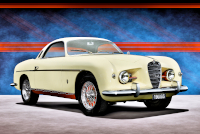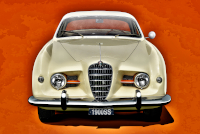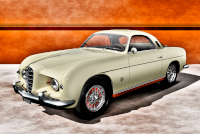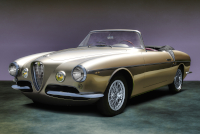Location:
Moda Miami, 2024
Owner: Richard Sirota | Irvington-on-Hudson, New York
Prologue:
Discussing the Supergioiello, Moda Miami emcee Nic Waller commented on how the 1900 series deserves attention for its breadth and variety. True indeed. The 1900 is a large, complicated, multi-faceted family that occupies nearly the entire decade.
Of this family, the 1900 'Super Jewel' is rare, and perhaps not well understood. And a bit awkward, the design, but for important reasons. Still I found myself indifferent at first glance, particularly in comparison with the Fiat 8V Supersonic alongside, which is an incredible design. But in the final illustrations I find enough uncommon style to enjoy the artistic process and appreciate how advanced Ghia's design philosophy was for the time.
Lately, the Bond Group of Waltham, Massachusetts brokered the sale of #01531. To see a reference for Waltham warms my heart as the city on the Charles just outside Boston was my second home growing up. My grandmother's old house is less than a mile away from the showroom, and if I remember correctly there was once a Maserati dealer on Linden back in the 1980s. So too was Sal's on Main the place for fried clams, just over the steel truss bridge, before the shop twice burned down. And over on Willow Street is the service station where John Paino maintained the odd antique, source of much fascination in my youth, and start of a lifelong interest in Pierce-Arrow.
To the extent that I recognize the geographic dispersion of contributions to the portfolio (and the broader 12cylinders catalogue), I appreciate that Waltham Ma can contribute.
- - - - - - - - - -
► Image source: Nikon D750 (24.3 MP)
References:
- Czap, Nick. "Museo Storico Alfa Romeo: The Catalogue" Giorgio Nada Editore, Milano, Italia. 2015, page 62-65
- d'Amico, Stefano. "Pure Alfa Romeo" Libri Illustrati Rizzoli, Milano, Italia. 2017, page 36, 101-102
- Garcia, Gonzalo Alvarez. "Alfa Romeo 1900 Sprint" Edizioni della Libreria dell'Automoble, Milano, Italia. 1983 page 73, 118
- Bond Group: Brokers for the recent sale of #01531.
- Bond Group: The brokers also provide this nice video walkaround and test drive, worth a check for the sights and sound.
- FCA Heritage: A quality source to understand the broader context of the Alfa Romeo 1900.
Believed to be the 1953 Milan Auto Show car, (no such claim I can confirm in my position), #01531 is one of three Ghia Supergioiello designs to survive on the 1900 platform. Ghia drafted this template a few years prior, dressing Alfa Romeo, Fiat, and Ferrari cars of more conventional ladder-frame chassis. What we see here is Ghia's adaptation of the Supergioiello concept on a unit-body platform, slightly modified to accept the custom coachwork.
While developed for the show circuit, this 1900 C retains the qualities that make the standard car so attractive to the sports enthusiast. Underpinned by unitary rigidity, riding on independent front suspension with a live rear axle, and breathing through the uprated twin-carb setup from the TI, the car is driver-focused. Ghia's coachwork is good complement, as the coachbuilder created every piece in aluminum. Even the fascia is an amazing complex of alloy moulded into the guards. The carrozzeria spared no effort in workmanship.
Those 1900 cars of race intent are predominantly Zagato exercises, whereas this Ghia Supergioiello design along with the more prolific Touring Superleggera echo the sentiment. But even the TI is just about as competition worthy.
The contrast lies within classic body-on-chassis construction versus the unitary construction method of the base car. The latter is naturally rigid and lightweight. The former makes concessions to the custom coachbuilding trade, but makes up for those concessions with the coachbuilders' knack for aerodynamics and comparably lightweight construction.
So the 1900 C Sprint is an interesting melting point between luxury convention and modern industry. And the Supergioiello is a rare gem, part of the great breadth and variety of the 1900 family.
Motor: 1,884 cc straight 4-cylinder, cast iron block, light-alloy hemi-head | 82.55 mm x 88 mm | 7.7:1 compression
Valvetrain: DOHC, chain-driven, 2 valves per cylinder
Aspiration: Dual twin-choke Weber 40 DCA carburetors
Note that one of the other two remaining Supergioiello cars, chassis #AR1900C-01549, uses a single Weber carburetor.
Power: 100 bhp at 5,500 rpm
Drivetrain: 4-speed gearbox, column-shift, rear-wheel drive
Front Suspension: independent wishbones, coil springs, and hydraulic dampers
Rear Suspension: live axle, trailing arms, triangular central element, coil springs, hydraulic dampers
Architecture: Part unitary construction with aluminum coachwork by Carrozzeria Ghia of Turin
Stefano d'Amico writes of the 1900 C platform, "Presented the day after the launch of the 1900 berlina, the inevitable 1900 C sports version has a shortened wheelbase, 100 hp, and a chassis 'for coachbuilders.' This means it was adapted so it could be dressed later, partly renouncing what had been the main innovation of the 1900: the self-supporting body." In this sense, we see a similar coachbuilder's dilemma Lancia faced with the original monocoque chassis. Advancing automotive production through unitary construction makes the carriage trade obsolete.
In the case of the 1900, direttore generale Iginio Alessio wanted to both advance mass-production at Alfa Romeo while also preserving the Italian coachbuilding trade. Alessio was a friend of Gaetano Ponzoni, Anderloni's partner at Touring, and of course Touring received contract work for the 1900 C Sprint and later 1900 CSS. But in total, Alfa produced five unitary chassis variations for customization, providing work for Boano, Ghia, Pinin Farina, Vignale, and Zagato. A defining feature of the 1900 C is the lower body's rigidity, which not only makes the 1900 a worthy competition platform, but also allows the top to be reconfigured or eliminated in the custom design process.
Wheelbase: 2,500 mm (98.4 in)
Top Speed: 170 km/h (105.6 mph)
Etymology:
'1900' refers to the displacement, which begins at 1,884 cc with the original series in 1950. The 'C' designation denotes a short chassis, or 'corto.' In 1953, the Sprint version adopts the higher compression head and twin carburetors from the 1900 TI (Turismo Internazionale), which arrived in 1952 as a sports version of the basic 1900.
This rare model 1900 C Sprint is the Supergioiello, or 'Super Jewel,' so named by coachbuilder Ghia. The name applies to the design, which Ghia previously dedicated to the Alfa Romeo 6C 2500, the Fiat 1400 and 1100, and also a lone Ferrari 212 Inter Berlinetta. The use of 'super' in this case may be counterpoint to Touring's all-too popular Superleggera system. For example, Ghia's Supersonic design reinforces the theme.
We also carry forth the berlinetta nomenclature from the classic 6C, as adopted by Italian grand touring cars of the post-War era. The term translates to 'little saloon' for Anglophiles, or 'little sedan' for the American palate, or just 'coupé' in simple French.
Note that the '1900SS' plate is partly disingenuous. In this case, 'SS' can only mean Sprint Supergioiello, which is not a factory designation but a combination of the 1900 C Sprint model and Ghia's body design. Typically 'SS' means Super Sprint in 1900 parlance, as in the 1900 CSS.
Figures:
Ghia built perhaps 18 of the Supergioiello Berlinetta on the 1900 C chassis. Some sources suggest Ghia built 19 such examples, or hedge and claim no more than 20, but whatever the case only three are known to survive. Also note that this limited coachwork run was originally larger than that of the Supersonic, but fewer remain.
Super Jewel: Features of Ghia's Supergioiello Adaptation for the Alfa Romeo 1900
What we mean by adaptation is this: By 1953, Ghia have already implemented the Supergioiello concept on the 1950 Alfa Romeo 6C 2500 chassis, as well as a lone Ferrari 212 Inter Berlinetta in 1951. These formative exercises are much different; they are leaner and more appropriately classic, more akin to Pinin Farina's Cisitalia 202 and its trim, cohesive form. The Supergioiello name also applies to Fiat applications on the 1400 and 1100 chassis—circa 1950 and 1951, respectively—but these exercises seem to take a different direction.
When in 1953 Ghia apply the design concept to the 1900 C platform, the result is interesting, but in some ways awkward. Although Alfa Romeo altered the unit-body platform for custom coachwork, Ghia must follow the relatively high crest of the fenders over the wheel arches. These same proportions dictate contemporary Pinin Farina and Touring lines on the 1900 C platform; they are all heavier in the cheeks than expected. Although the top could be formed to the coachbuilder's liking, one clearly sees the original 1900 proportions under the Ghia body.
What Ghia can control more handily is the fascia, presenting their signature bespectacled accountant expression by housing the lights inside linear ducts, either side of the grille. Not so much classic, the design predicts mass-market car design roughly 20 years in the future, while at a glance it is unmistakably Ghia.
Ghia taper and crease the fenders, creating subtle fins. But the squareness of the proportions is another of the coachbuilder's hallmarks, and rather similar to the trans-Atlantic exercises Ghia created for Chrysler. The little 1900 C Sprint Supergioiello is in many ways a small-scale version of the 1953 Chrysler Ghia Special. Not entirely, but the sensibility is the same—the tuck at the shoulder, the contoured top, the clean flank and hard corners.
In other words, the Supergioiello is a design language Ghia employ often, and in many different capacities. Ghia begin with traditional coachbuilt platforms, then adapt the design for Italian and American audiences alike. Different cars at different scales, these are truly modern designs at a time when most automotive artists trend toward heavy embellishment.
Ombra di Zucca: Accent and Ornament on the 1900 C Sprint Supergioiello
Against the broad sandstone body, the car uses a rather effective pumpkin shade for contrast. Uncertain whether the combination is original, but the pairing is smart.
At once the bright facing on the brake drums evokes classic era copper linings, tied together by the colored rockers and accented by two fine chrome strips. Ghia only use a fine spear and line accent along the flank, keeping the profile clean, and create a pocket to set their badge in relief just aft of the front arches. More surprising, the knock-off hubs, center of each Borrani wire wheel, use orange lettering, an unexpected, jewelry-like accent.
The fascia uses orange accents in both prominent and surprising places—mainly in the horizontal brows within each scultped duct, also around the inner shroud of the headlamps, and cleverly behind the chromed guard. The peek of color under the chrome creates interesting multicolor reflections and helps integrate the otherwise large bumper into the front-end sculpture.
The grille is itself one-third of Alfa Romeo's redesigned trilobate fascia, born on the 1900 berlina and retained on both Pinin Farina and Touring designs. In this case, Ghia replace the two horizontal lobes with those deep ducts while bringing the lights inboard.
The balance of the ornament is restrained. A single chrome line begins at the nose but ends partway over the bonnet. Three simple chrome slants on the B-pillars accent the gentle taper of the hood. And the tail treatment is American expression with modest fins and tall, faired-in lights, combined with a classic Alfa Romeo fixture. The design inherits from the 6C 2500 SS a large, lighted pediment over the number plate. This piece is perhaps the lone accent that connects the Supergioiello design to its Alfa Romeo predecessors.
Last Updated: Jun 7, 2025







